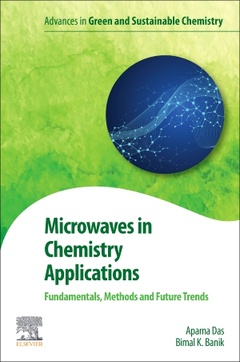Microwaves in Chemistry Applications Fundamentals, Methods and Future Trends Advances in Green and Sustainable Chemistry Series
Auteurs : Das Aparna, Banik Bimal Krishna

Microwaves in Chemistry Applications: Fundamentals, Methods and Future Trends offers a number of benefits over conventional heating technologies, including acceleration of reaction rates, milder reaction conditions, higher chemical yields, lower energy usage and different reaction selectivity, all of which can improve the sustainability of processes. The book provides valuable insights into the underlying chemistry at play in microwave-assisted processes, introducing fundamental concepts, discussing the modeling of reactions in such processes, and also highlighting a range of key methods and applications of microwaves in chemistry for improved sustainability.
Beginning with an introduction to microwave chemistry, Part One discusses foundational principles, equipment and approaches for modeling reactions and assessing the outputs of those models. Methods in microwave chemistry are then the focus of Part Two, with microwave-assisted synthesis, catalysis, reduction and reactions all explored in detail. Part Three reflects on the practical usage of these methods to address specific issues, covering a number of interesting applications.
1. Foundational principles of microwave chemistry
2. Microwave equipment for chemistry
3. Modelling and interpreting microwave effects
4. Microwave-assisted synthesis of oxygen and sulphur heterocycles
5. Microwave-assisted synthesis of nitrogen heterocycles
6. Microwave-Assisted Oxidation and Reduction Reactions
7. Microwave-Assisted Enzymatic Reactions
8. Microwave-Assisted Sterilization
9. Microwave-enhanced CVD processes for diamond synthesis
10. Future trends in microwave chemistry and biology
Since being awarded his PhD by the Indian Association for the Cultivation of Science, Calcutta, Professor Banik has held positions as a Postdoctoral Fellow at Case Western Reserve University and Stevens Institute of Technology; Tenured Full Professor in Chemistry and First President’s Endowed Professor in Science & Engineering at the University of Texas-Pan American, Edinburg; an Assistant Professor in Molecular Pathology at the University of Texas M. D. Anderson Cancer Center, Houston; and a Research Assistant Professor in Chemistry & Chemical Biology at Stevens Institute of Technology, New Jersey. Since 2014, he has been the Vice President of Research & Education Development
- Provides guidance on the modeling and interpretation of microwave effects
- Discusses microwave chemistry in the context of green chemistry principles
- Outlines a range of important microwave methods, including microwave-assisted synthesis, catalysis, reactions and reductions
Date de parution : 05-2021
Ouvrage de 410 p.
15.2x22.8 cm
